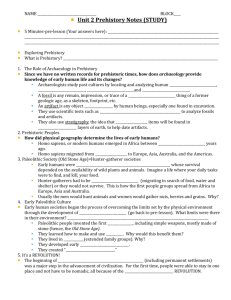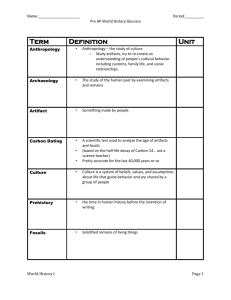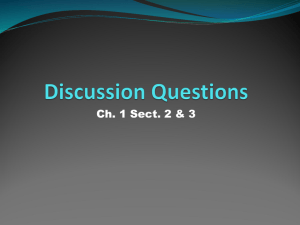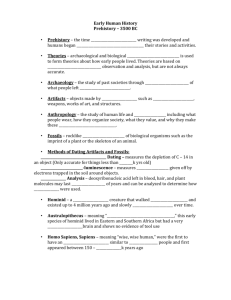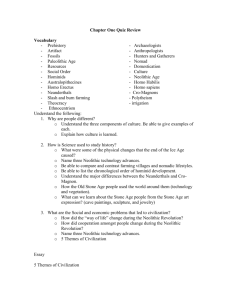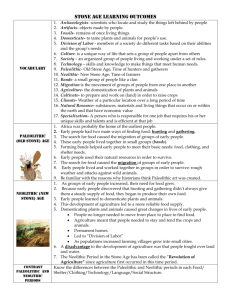Study Guide Powerpoint
advertisement
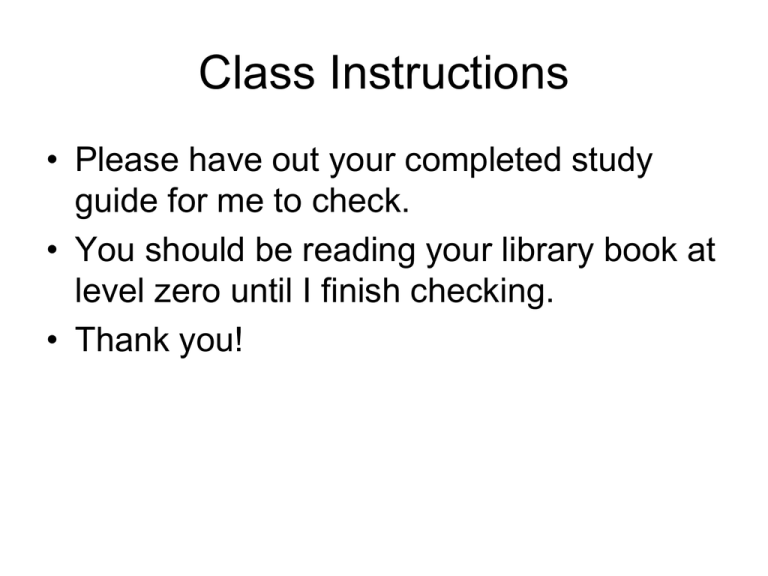
Class Instructions • Please have out your completed study guide for me to check. • You should be reading your library book at level zero until I finish checking. • Thank you! Chapter 1-2 Study Guide Social Studies 7 Burnette & Davis Fall 2013 ER 1 – Domestication • Domestication is making plants and animals useful to humans • Plants=year round food supply, surplus, eliminate the need to gather over long distances • Animals=power supply, protection, and food supply • Impact = allowed for people to settle • Created a stable food supply ER 2 – Impact Today • Development of cities and towns • Farmers raise livestock for meat and milk • Farmers grow crops according to climate and season • Development of farming technology over time (plows, harvesters, irrigation systems, hybrid foods, etc) MC 1 - Historians • Historians are interested in studying the knowledge, beliefs, and customs of people MC 2 - Archaeologists • Archaeologists are interested in things that people leave behind throughout history. • Study sites such as ancient battle fields, settlements, and burial grounds. MC 3 – What does history teach…? • History teaches people about their past. • History teaches people about how their government came into existence. • History acknowledges triumphs and tragedies. MC 4 - Culture • Culture is the beliefs, customs, and art of a group of people MC 5 – Primary Sources • A primary source is an account of an event created by someone who took part in the event. • Examples of primary sources are treaties, letters, diaries, laws, court documents, and royal commands MC 6 – Secondary Source • A secondary source is information gathered by someone who did not take part in or witness an event. • Examples of secondary sources are textbooks, journal articles, and encyclopedias. • These are often Historian’s opinions on events. MC 7 – Historians Interpret • Sometimes, historians interpret events differently because of they form different opinions about the primary sources they study. MC 8 – Studying History Helps • Studying history leads you to ask important questions. • Studying history forces you to analyze facts. • Studying history helps you identify main facts. MC 9 – Early Man • Early forms of man are known as HOMINIDS. • These are the ancestors of modern man. MC 10 – Stages of human development • • • • Homo habilis = “handy man” Homo erectus = “upright man” Homo sapiens = “wise man” All modern humans today are Homo sapiens. MC 11 - Tools • Tools helped early humans because they increased the chances for survival. MC 12 – First skill… • Early humans developed first the ability to make tools. • Once they developed tools, many parts of their daily lives were made easier. MC 13 - Society • A society is a community of people who share a common culture. MC 14 – Three reasons language developed • Language was developed to make hunting easier. • Language was developed to form new relationships. • Language was developed to resolve issues like distributing food. MC 15 – Tools of Middle Stone Age • People developed more complex tools like fishing hooks and fishing spears out of wood and bone. MC 16 – Which Stone Age… Religion? • Historians and archaeologists believe that the first ideas of religion were developed in the OLD STONE AGE (or, the Paleolithic Era) from the Cave Art paintings. MC 17 – Ice Ages • Early humans were forced to move to new environments as the result of the Ice Age!!! MC 18 – Three Stone Ages • PALEOLITHIC (Old Stone Age) – simple stone tools used for cutting and scraping, cave paintings (art & religion), early language • MESOLITHIC (Middle Stone Age) – animal skin clothing, shelters and more complex tools out of wood and bone • NEOLITHIC (New Stone Age) -domestication of plants and animals, settlement, learned how to make fire MC 19 – Clothing & Shelter • People needed better clothing and shelter as they migrated out of Africa because they needed more protection to survive in colder areas. MC 20 – Neolithic Revolution • The Neolithic Revolution is defined as the time in history where there was a shift from food gathering to food producing. • People slowly stopped relying only on hunting and gathering for their food supply and began raising animals and crops. MC 21 - Farming • With the development of farming, people were able to create settlements and build permanent shelters MC 22 – List the order of settlements 1. 2. 3. 4. 5. AFRICA EUROPE & ASIA AUSTRALIA NORTH AMERICA SOUTH AMERICA MC 23 – Settlement of N. Amer • A land bridge over the Bering Strait thousands of years ago aided in the settlement of North America. This land bridge connected Russia and Alaska. MC 24 - Megaliths • Megaliths are large stone monuments that historians believe were used during religious ceremonies and as monuments to early gods and goddesses during the Neolithic Era.

